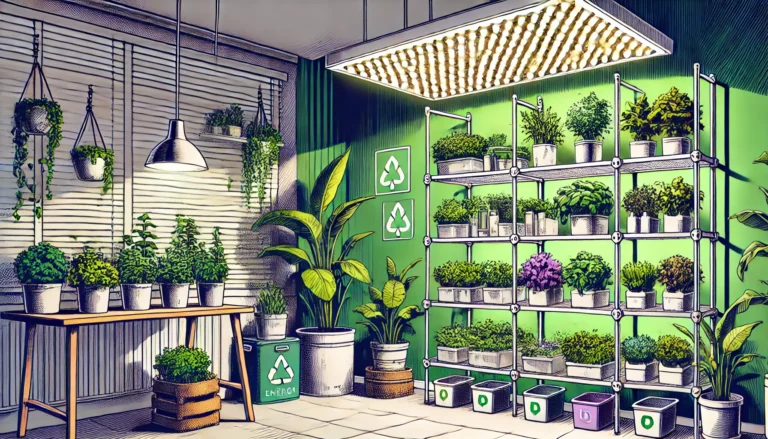Table of contents
- Introduction: Environmental Impact and Energy Efficiency of LED Grow Lights
- Why Choose Energy-Efficient LED Grow Lights?
- LED Grow Lights vs. Traditional Grow Lights
- Top Eco-Friendly LED Grow Lights
- Spider Farmer SF-1000 vs. Mars Hydro TS 1000
- Energy-Saving Accessories for LED Grow Lights
- Smart Plugs and Energy Monitors
- How to Optimize Energy Efficiency in Indoor Gardening
- Choosing Green-Friendly and Energy Star-Rated Products
- Key Features of Green-Friendly Products
- Conclusion: Making Sustainable Choices for Indoor Gardening
Introduction: Environmental Impact and Energy Efficiency of LED Grow Lights
The environmental impact and energy efficiency of LED grow lights make them an ideal choice for eco-conscious gardeners looking to save energy while supporting sustainable indoor gardening practices.
Are you looking for an affordable way to grow plants indoors without harming the planet? LED grow lights offer a:
- Sustainable solution that reduces your carbon footprint.
- Energy-efficient option that saves money on energy bills.
- Perfect choice for eco-conscious indoor gardeners.
This guide covers:
- Top budget-friendly LED grow lights, including:
- Spider Farmer SF-1000
- Mars Hydro TS 1000
- Energy-saving accessories, such as:
- Smart plugs
- Energy monitors
Whether you’re new to indoor gardening or upgrading your setup, this article will help you:
- Make informed, sustainable choices.
- Create a greener, more energy-efficient indoor garden.
Let’s explore the environmental and economic benefits of LED grow lights and transform your indoor garden into a green oasis! To help you balance power usage with performance, you can explore our guide to the best LED grow lights for indoor gardens.
Why Choose Energy-Efficient LED Grow Lights?
LED grow lights have revolutionized indoor gardening by offering a blend of efficiency, sustainability, and affordability. Here’s why they’re the top choice for eco-conscious gardeners:
Cost Savings
- LED grow lights consume significantly less energy than traditional grow lights, such as HPS or fluorescent lamps.
- Their long lifespan reduces the need for frequent replacements, saving you money over time.
- Energy-efficient models, like the Spider Farmer SF-1000 and Mars Hydro TS 1000, offer high performance without breaking the bank.
Environmental Benefits
- Lower Carbon Footprint: LED lights use less electricity, which reduces greenhouse gas emissions from power generation.
- Reduced Waste: Their durability means fewer lights end up in landfills compared to traditional bulbs.
- Sustainability Features: Many models, such as Energy Star-certified LEDs, are designed to meet eco-friendly standards.
Understanding the environmental impact and energy efficiency of LED grow lights is crucial for reducing electricity usage and contributing to a healthier planet.
Improved Indoor Gardening Experience
- Optimal Light Spectrum: LEDs provide a full spectrum of light, promoting healthier plant growth at all stages.
- Cooler Operation: Unlike traditional lights, LEDs produce minimal heat, reducing the risk of overheating plants and ensuring a safer environment.
LED Grow Lights vs. Traditional Grow Lights
| Feature | LED Grow Lights | Traditional Grow Lights |
| Energy Efficiency | High (uses ~50% less energy) | Low (high energy consumption) |
| Lifespan | 50,000+ hours | 10,000–15,000 hours |
| Heat Output | Low | High |
| Light Spectrum | Full spectrum for all growth stages | Limited, may need additional bulbs |
| Environmental Impact | Low carbon footprint | High carbon footprint |
| Cost Over Time | Cost-effective (energy savings + long life) | Expensive (frequent replacements + energy costs) |
Why It Matters
By choosing energy-efficient LED grow lights, you’re not just improving your indoor garden—you’re also contributing to a healthier planet. Plus, you’ll enjoy long-term cost savings and better results for your plants.
Top Eco-Friendly LED Grow Lights
Choosing the right LED grow light can make a significant difference in your indoor gardening experience. Below, we highlight two of the most eco-friendly and energy-efficient models that balance performance and sustainability.
Spider Farmer SF-1000
- Features:
- Full-spectrum light that supports all stages of plant growth.
- High energy efficiency with a power draw of only 100W, saving up to 50% on electricity compared to traditional lights.
- Long lifespan of over 50,000 hours, reducing waste and replacement costs.
- Compact, lightweight design ideal for small to medium indoor gardens.
- Best For:
- Small-scale growers looking for a budget-friendly, energy-efficient option.
- Why It’s Eco-Friendly:
- Low energy consumption reduces your carbon footprint.
- Uses advanced technology for better light distribution and minimal heat output.
Mars Hydro TS 1000
- Features:
- Full-spectrum lighting with exceptional PAR output for healthy plant growth.
- Energy-efficient design with a power draw of 150W, making it ideal for medium-sized setups.
- Durable and lightweight, with a lifespan of over 50,000 hours.
- Enhanced reflective hood design for maximizing light distribution.
- Best For:
- Growers needing higher light output for medium-sized gardens or larger plants.
- Why It’s Eco-Friendly:
- Energy-saving performance reduces electricity costs.
- Manufactured with sustainability in mind, offering long-term use with minimal waste.
Spider Farmer SF-1000 vs. Mars Hydro TS 1000
| Feature | Spider Farmer SF-1000 | Mars Hydro TS 1000 |
| Power Draw | 100W | 150W |
| Coverage Area | 2′ x 2′ | 3′ x 3′ |
| Lifespan | 50,000+ hours | 50,000+ hours |
| Light Spectrum | Full spectrum | Full spectrum |
| Best For | Small indoor gardens | Medium-sized indoor setups |
| Eco-Friendly Benefit | Low energy usage, reduced waste | Energy-efficient, sustainable |
How to Choose the Right Light
- For Smaller Spaces: Spider Farmer SF-1000 offers excellent performance with minimal power consumption, ideal for hobbyists or small-scale growers.
- For Larger Plants or Medium Spaces: Mars Hydro TS 1000 provides higher light output, ensuring robust growth in slightly larger setups.
For more insights into the top-performing LED grow lights, check out our detailed guide on the Best LED Grow Lights for Indoor Gardens in 2025.
Energy-Saving Accessories for LED Grow Lights
Pairing your LED grow lights with energy-saving accessories can further enhance efficiency, reduce energy costs, and optimize your indoor gardening experience. Here are two essential accessories every eco-conscious gardener should consider.
Smart Plugs
- What They Do:
- Automate your light schedules with precision.
- Enable remote control via smartphone apps to turn lights on or off from anywhere.
- Energy-Saving Benefits:
- Avoid leaving lights on longer than necessary, reducing energy waste.
- Tailor light cycles to specific plant needs, ensuring efficient energy use.
- Top Picks:
- TP-Link Kasa Smart Plug: Features scheduling, timers, and energy monitoring.
- Amazon Smart Plug: Easy integration with Alexa for voice control.
- Affiliate Opportunity: Link to reliable, energy-efficient smart plugs.
Energy Monitors
- What They Do:
- Track real-time energy usage of your grow lights and other accessories.
- Provide insights into energy consumption, helping you adjust for better efficiency.
- Energy-Saving Benefits:
- Identify inefficient devices and adjust settings to save power.
- Calculate running costs for better budgeting.
- Top Picks:
- Kill-A-Watt Energy Monitor: Easy-to-use device for tracking electricity usage.
- Eve Energy Monitor: Includes energy tracking and smart scheduling features.
- Affiliate Opportunity: Link to energy monitors that are user-friendly and cost-effective.
Smart Plugs and Energy Monitors
| Feature | Smart Plugs | Energy Monitors |
| Primary Function | Automate schedules, remote control | Track and analyze energy usage |
| Energy-Saving Potential | High (prevents overuse) | Medium (insights for optimization) |
| Best For | Controlling light schedules | Understanding energy consumption |
| Ease of Use | Easy (via apps or voice control) | Moderate (requires setup and tracking) |
| Eco-Friendly Benefit | Reduces unnecessary energy waste | Identifies inefficiencies for correction |
How to Use These Accessories Together
- Combine smart plugs and energy monitors for a fully optimized system.
- Example: Use a smart plug to schedule precise lighting cycles and an energy monitor to evaluate and refine usage patterns over time.
How to Optimize Energy Efficiency in Indoor Gardening
Maximizing the efficiency of your LED grow lights involves more than just choosing the right equipment. Strategic placement, smart scheduling, and proper maintenance can significantly enhance performance while reducing energy waste.
Placement Tips
- Correct Height and Distance:
- Adjust light height according to the growth stage of your plants.
- Seedlings: 24–36 inches above plants.
- Vegetative Stage: 18–24 inches above plants.
- Flowering Stage: 12–18 inches above plants.
- Use the manufacturer’s recommendations for best results.
- Adjust light height according to the growth stage of your plants.
- Reflective Materials:
- Line walls or growing areas with reflective materials like Mylar or white paint.
- Reflective surfaces maximize light coverage and reduce the need for additional lights.
Light Scheduling
- Tailor light cycles to the type of plants you’re growing:
- Vegetative Stage: 16–18 hours of light per day.
- Flowering Stage: 12 hours of light per day.
- Use smart plugs (see Section 3.1) to automate schedules for consistency and efficiency.
Maintenance Practices
- Regular Cleaning:
- Dust and debris on LEDs can reduce light output and efficiency.
- Clean light surfaces with a soft cloth and mild cleaner every 1–2 months.
- Check for Wear and Tear:
- Inspect wiring and connectors to ensure everything is functioning safely.
- Replace components promptly to maintain energy efficiency.
Energy Optimization in Action
For example, using a Spider Farmer SF-1000 positioned at 18 inches during the vegetative stage, combined with reflective walls and a smart plug schedule, can cut energy waste by up to 30%. Regular cleaning ensures the light maintains peak performance throughout its lifespan.
Choosing Green-Friendly and Energy Star-Rated Products
When selecting LED grow lights and accessories, opting for green-friendly and Energy Star-rated products ensures that you’re prioritizing both sustainability and energy efficiency. These certifications guarantee reduced energy consumption and long-term environmental benefits.
What Makes a Product Green-Friendly?
- Energy Star Certification:
- Indicates that a product meets strict energy efficiency guidelines set by the U.S. Environmental Protection Agency (EPA).
- Reduces energy costs and minimizes environmental impact.
- Sustainable Manufacturing Practices:
- Products made with eco-friendly materials and minimal waste during production.
- Longevity and Durability:
- Long-lasting products reduce the need for frequent replacements, lowering waste.
For comprehensive information on energy-efficient lighting and its environmental benefits, visit the EPA’s guide on Energy Star Certified Light Bulbs.
Benefits of Energy Star-Rated LED Grow Lights
- Energy Savings:
- Use up to 25% less energy than standard models.
- Reduce electricity bills while maintaining high performance.
- Environmental Impact:
- Lower greenhouse gas emissions from reduced power consumption.
- Performance Assurance:
- Tested for consistent output and reliability, making them ideal for long-term use.
Top Picks for Green-Friendly Grow Lights
- Spider Farmer SF-1000:
- Features high energy efficiency and a long lifespan.
- Designed for small indoor gardens with sustainability in mind.
- Mars Hydro TS 1000:
- Combines eco-conscious design with powerful performance for medium setups.
- Affiliate Integration:
- Provide links to Energy Star-rated options and other eco-friendly products.
Key Features of Green-Friendly Products
| Feature | Spider Farmer SF-1000 | Mars Hydro TS 1000 | Energy Star-Rated Products |
| Energy Efficiency | High | High | Verified by EPA guidelines |
| Lifespan | 50,000+ hours | 50,000+ hours | Durable for long-term use |
| Eco-Friendly Materials | Yes | Yes | Varies by product |
| Certification | Not certified, eco-friendly | Not certified, eco-friendly | Energy Star |
Tips for Choosing Certified Products
- Look for the Energy Star logo when shopping for grow lights and accessories.
- Research manufacturer claims to ensure they align with eco-friendly practices.
- Check product reviews and specifications to confirm energy efficiency ratings.
Conclusion: Making Sustainable Choices for Indoor Gardening
LED grow lights are a game-changer for indoor gardening, offering a perfect blend of energy efficiency, affordability, and environmental sustainability. By investing in eco-friendly models like the Spider Farmer SF-1000 or Mars Hydro TS 1000, and pairing them with energy-saving accessories such as smart plugs and energy monitors, you can create a greener, cost-effective gardening setup.
Here’s what you’ll achieve:
- Lower Energy Costs: LED grow lights and smart accessories save money on electricity bills.
- Reduced Environmental Impact: Sustainable products minimize waste and carbon footprints.
- Improved Plant Growth: Full-spectrum, energy-efficient lighting supports healthy plants at all stages.
By prioritizing the environmental impact and energy efficiency of LED grow lights, gardeners can achieve sustainable results while minimizing costs and supporting a greener future.
As an eco-conscious gardener, every choice you make has a ripple effect on the planet. By opting for Energy Star-rated and green-friendly products, you’re not just cultivating your garden—you’re fostering a more sustainable future. If you’re setting up a grow space, you can find our top picks for energy-efficient lights for 4×4 tents.
Ready to make your indoor garden eco-friendly? Explore the recommended products linked throughout this article to start your journey toward sustainability. Let’s grow together—sustainably!





